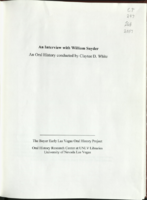Search the Special Collections and Archives Portal
Search Results
Joy Rineer oral history interview
Identifier
Abstract
Oral history interview with Joy Rineer conducted by Claytee D. White on December 07, 2017 for the Remembering 1 October Oral History Project. In this interview, Rineer discusses her upbringing in Las Vegas, Nevada. She describes her career as an architect, designing the Resilience Center for those affected by the 1 October shooting, and the city’s response to the shooting. Later, Rineer describes helping the grief-stricken city through architecture, establishing the Leadership Las Vegas program, and organizing blood drives. Lastly, Rineer discusses the changes in Las Vegas after the tragedy.
Archival Collection
George Tate oral history interview
Identifier
Abstract
Oral history interview with George Tate conducted by Randi Levine and June Brown on September 24, 2002 as part of the UNLV University Libraries Oral History Collection. In this interview, Tate discusses his personal history, his occupation as an architect, and his experience in the United States Army Corps of Engineers. He explains why ground water was an issue for building infrastructure in Las Vegas, Nevada. Lastly, Tate discusses the changes in the professional architectural community, the increase of women in the architectural field, and the competitive aspect of being an architect.
Archival Collection

Transcript of interview with Paul Senzaki, Alan Hess, and Charlie White III by Stefani Evans and Claytee White, September 9, 2016
Date
Archival Collection
Description
Architect Paul Senzaki, and artist-illustrator Charlie White III recall their experiences of working in Las Vegas: Paul on Treasure Island, The Palms, Fremont Street Experience, and World Market Center and Charlie on Treasure Island and its successor, TI; New York New York. Architectural historian Alan Hess, who is an expert on Las Vegas architecture, offers historical context and asks pertinent questions. While this interview touches on several iconic Las Vegas buildings, the conversation mostly details why and how Steve Wynn's Treasure Island involved the labors of artists, illustrators, art directors, and designers of stage and screen as well as the those of architects, contractors, planners, and subcontractors.
Text

Transcript of interview with Bill Snyder by Claytee White, November 21, 2008
Date
Archival Collection
Description
In 1978 Bill Snyder came Las Vegas for a heavyweight championship fight between his homeboy, Larry Holmes and Ken Norton. During that visit, he saw cranes dotting the cityscape so he returned home and proposed that the family move across country and settle in the desert. His wife, Joy, gave him a year. And as they say, the rest is history. And what am amazing history it is. In this interview, Bill Snyder talks about his life from its beginning in Easton, Pennsylvania, where he discovered the challenge of architecture first by perusing books in the library and then by hands-on construction experience. But his love of art built the foundation to this treasured craft that has allowed him to design homes, office buildings, airport terminals and the McCaw School of Mines on the campus of McCaw Elementary School in Henderson, NV. The projects that Mr. Snyder seems to prize most are those that include the imagination of children. The people who shaped his life are introduced and the impact of his military training is wonderfully expressed. His connection with young people is paramount throughout the oral history that is beautifully documented with images of many of the projects that displayed children's art in an exciting way. Bill and Joy are the parents of two sons. Dana age 36, lives with his wife Christine in Hollywood, California, and works as a voice actor best known for his role as Master Shake on the cartoon Aqua Teen Hunger Force. Their younger son, Mike age 31, owns The Krate, a clothing, music, and art shop in Santa Cruz, California, where he lives with his wife Mandy and daughter Maya. A husband, father, sports car enthusiast, runner, thinker and lover of teaching and trusting young people, Bill Snyder is a brilliant architect and manager of people. He is dyslectic and never expected a school to be named in his honor but the William E. Snyder Elementary School was dedicated in 2001 with overwhelming community support. One of his current goals is to dream an architectural project that rivals the McCaw School of Mines for his own school. I trust that you will learn to love architecture in a different and very profound way as you read this interview just as I did during my conversation with Bill.
Text
Daniel Van Epp oral history interview
Identifier
Abstract
Oral history interview with Daniel Van Epp conducted by Stefani Evans on April 19, 2017 for the Building Las Vegas Oral History Project. In this interview, Van Epp discusses his upbringing in Virginia. He talks about his initial interest in architecture, moving to Las Vegas, Nevada in 1995, and becoming President of the Howard Hughes Corporation. Van Epp recalls the development of Summerlin, the increase of homes being built in that area, and the construction of the I-215 Beltway. Lastly, Van Epp discusses master planning communities and the construction of Symphony Park in downtown Las Vegas.
Archival Collection
Las Vegas High School Architectural Drawings
Identifier
Abstract
The Las Vegas High School architectural drawings include blueprints for various improvements, expansions, additions, and renovations performed for the Las Vegas, Nevada high school between 1929 and 1972. The architectural drawing sets include site plans, floor plans, elevations, sections, building component details, and structural drawings.
Archival Collection
MacDonald Ranch Architectural Records
Identifier
Abstract
The MacDonald Ranch Architectural Records contain master plans, architectural drawings, civil drawings, and landscape drawings primarily detailing the community development process of MacDonald Ranch, one of the oldest and most affluent master-planned communities in Clark County, Nevada between 1972 to 2007. Included are also drawings for MacDonald Highlands and Green Valley Ranch.
Archival Collection
Paul Senzaki, Alan Hess, and Charlie White III roundtable interview
Identifier
Abstract
Roundtable interview with Paul Senzaki, Alan Hess, and Charlie White III conducted by Stefani Evans and Claytee D. White on September 09, 2016 for the Building Las Vegas Oral History Project. Senzaki and White III discuss their separate work on the development of many Las Vegas, Nevada Strip hotels and casinos. Hess talks about his expertise on Las Vegas architecture.
Archival Collection
Domingo Cambeiro oral history interview
Identifier
Abstract
Oral history interview with Domingo Cambeiro conducted by Stefani Evans and Claytee D. White on October 18, 2016 for the Building Las Vegas Oral History Project. In this interview, Cambeiro discusses his upbringing in Havana, Cuba. He talks about his initial interests in architecture, starting his own architecture drawing service, and attending the University of Havana. Cambeiro recalls submitting a request to leave Cuba, emigrating to the United States, and arriving in Las Vegas, Nevada in 1962. Cambeiro talks about working with Las Vegas architect Julius Gabriel, obtaining his architecture license, and starting an architectural firm. Lastly, Cambeiro discusses being selected to create architectural drawings for the Thomas & Mack Center.
Archival Collection
Joy Rineer oral history interview
Identifier
Abstract
Oral history interview with Joy Rineer conducted by Stefani Evans on December 01, 2017 for the Building Las Vegas Oral History Project. In this interview, Rineer talks about growing up in Las Vegas, Nevada. She recalls her educational experience in Las Vegas, attending the University of Utah, and studying architecture. Rineer explains how architectural education, internships, testing, and licensing processes have evolved over time, and how these processes formerly limited opportunities for women in architecture. Rineer also reflects on projects she has worked on personally, her employment with architecture firm Simpson Coulter Studio, and the firm's emphasis on community-anchored architecture. Lastly, Rineer discusses planning for schools, and changing classroom layouts to accommodate different learning styles.
Archival Collection
